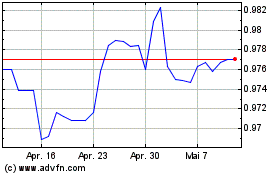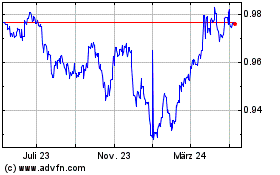Euro Mixed After ECB Rate Decision; Awaits Draghi's Speech For Addl. Measures
22 Januar 2015 - 2:28PM
RTTF2
The euro traded mixed against its major counterparts in European
deals on Thursday, after the European Central Bank left its key
interest rates steady at a record low for a fourth straight month.
Meanwhile, the ECB indicated that it will flesh out further details
regarding monetary policy measures at the President Draghi's press
conference, due shortly.
The Governing Council, led by President Mario Draghi, held the
refinancing rate at a record low 0.05 percent, following the
meeting in Frankfurt. The decision was in line with economists'
expectations.
The bank also left the deposit rate unchanged at -0.20 percent
and the marginal lending rate at 0.30 percent. The three main
interest rates were lowered by 10 basis points in September.
Since the ECB has given no indications on its planned QE
programme in the initial policy statement, investors await Draghi's
speech for more on it.
In his customary post-decision press conference at 8.30 am ET,
Draghi is expected to unveil a massive quantitative easing plan,
widely seen to exceed EUR 1 trillion. The QE programme, which was
initially seen to be around EUR 500-550 billion, could include
buying government bonds despite strong criticism from Germany.
Reports citing ECB sources said the bank may opt to buy EUR 50
billion of bonds per month. The plan was also rumored to run
through 2016.
The euro has been trading in a negative territory in January,
amid uncertainty regarding the consequences of the Greek elections
on January 25, speculation that the ECB would launch sovereign bond
purchases at the earliest and on plunging oil prices that raises
the prospect of outright deflation.
The euro bounced off to 1.1649 against the U.S. dollar, up by
0.6 percent from a low of 1.1575 hit at 2:30 am ET. The euro is
likely to find resistance around the 1.20 zone.
The euro slipped to a 2-day low of 0.7613 against the Sterling,
compared to 0.7665 hit late New York Wednesday. The euro is poised
to find support around the 0.75 mark.
U.K. budget deficit increased in December from last year, data
from the Office for National Statistics showed.
Public sector net borrowing excluding public sector banks
totaled GBP 13.1 billion, an increase of GBP 2.9 billion or 27.8
percent from last year.
Having advanced to a 2-day high of 137.30 against the yen in
Asian deals, the euro eased with pair trading at 136.86. Next key
support for the euro may be located around the 135.6 region.
The Bank of Japan assessed that the Japanese economy is
recovering at a moderate pace, but inflation is likely to slow,
according to the Monthly Report on Recent Economic and Financial
Developments.
Japan's economy has continued to recover moderately as a trend
as the effects of the decline in demand following the sales tax
hike have been waning on the whole, it said.
The euro reversed from an early high of 1.0031 against the Swiss
franc and was trading lower at 0.9930. If the euro slides further,
0.965 is likely seen as its next downside level.
Looking ahead, U.S. weekly jobless claims for the week ended
January 17 and house price index for November are due in the New
York session.
At 10:00 am ET, Eurozone flash consumer sentiment index for
January is to be released.
Euro vs CHF (FX:EURCHF)
Forex Chart
Von Apr 2024 bis Mai 2024

Euro vs CHF (FX:EURCHF)
Forex Chart
Von Mai 2023 bis Mai 2024
